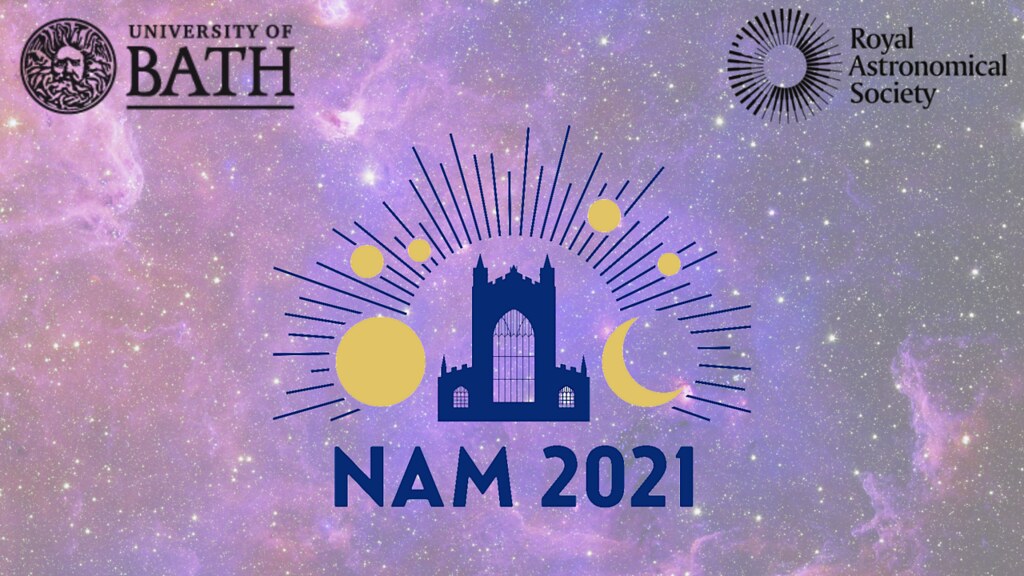The connection between quantum physics and jazz improvisation? What does a galaxy feel like? What is producing the most energetic outbursts of radio emission ever seen? And is a “planet X” lurking beyond the orbit of Neptune?
Participants from 42 countries virtually attended the National Astronomy Meeting (NAM2021) to find out the answers to these questions. Despite the challenges of the pandemic, NAM2021 was the largest and most accessible annual meeting of the Royal Astronomical Society (RAS) ever, with over 950 participants.
Suitably hosted by Bath, home to the RAS’s first president, William Herschel, the bicentennial conference featured significant star power including recipients of this year’s Shaw prize, the American Astronomical Society’s Russell lectureship prize, and the RAS’s own Gold Medal. At the same time, it shone a spotlight on the achievements of early career researchers and students, some of them presenting for the first time on an international stage. In a field where gender imbalance remains persistent, with the fraction of women professional astronomers hovering around one fifth, women represented half of the cast of plenary speakers and one-third of the nearly 500 delegates presenting their work during the conference week. Also in a broader sense a theme of inclusivity ran as a thread through the programme: from dedicated sessions on diversity to public engagement activities for the visually impaired and attention for the culturally sensitive sites where observational astronomers and their telescopes are fortunate to be guests. NAM2021 brought together amateur and professional astronomers in their fight against light pollution, illustrated the enriching perspectives enabled through art-science collaborations, and had astronomers and magnetosphere, ionosphere and Solar-Terrestrial physicists jointly trying their hands in a series of workshops and interest sessions on novel machine learning techniques.
Lunchtime sessions offered a sampler of the diverse career paths enabled by an education in science, an occasion to reflect on astronomers’ roles and responsibilities in a greener and more sustainable world, and discussions on effective ways to bring discoveries of a new generation of telescopes closer to the public.
Running alongside the daytime programme, NAM2021 delegates and the broader public were treated to the tunes of Herschel’s musical compositions, an evening of science comedy and a hot-off-the-press update on ongoing Mars missions, masterfully curated by the Bath Public Engagement team and RAS.
Along with the celebration of the science and research being conducted by Astronomers and Geophysicists across the UK and beyond, NAM2021 also provided a reason for sober reflection, as the results of the RAS’s own bullying and harassment survey were presented, showing that bullying and harassment are endemic, and that the brunt of this is borne by women, ethnic minorities, people with marginalized sexual orientations or gender identities (LGBT+ people), and disabled people. While certainly disconcerting, the results did not come as a surprise to the RAS researchers who conducted the survey, with the RAS leadership pledging to do as much as possible to address this widespread problem. “The results from the survey are very concerning indeed, and we must act to change this unacceptable situation,” said RAS president Professor Emma Bunce in an interview with Nature.
NAM2021 had delegate avatars walking around a massive virtual poster room, generous sponsors in exhibit booths, a live streaming sunrise from Stonehenge, plenty of audience questions and comments flowing over into fruitful scientific discussions on Slack, and loads of virtual clapping hands, as well as the inevitable occasional “you are muted”, screen-share hiccup or a speaker seemingly dropping off the face of the internet. But with every technical hurdle cleared, so grew the confidence of the crew of NAMbassadors (volunteering students, postdocs and staff from the Bath Astrophysics and Electronic & Electrical Engineering research groups), ensuring a smooth experience for all delegates.
With the successful conclusion of the week’s talks and plenaries on Friday evening, the Bath team gratefully handed over the baton of running the National Astronomy Meeting to NAM2022’s organizing committee at the University of Warwick, who plan on building on the overwhelming success of Bath’s virtual event by hosting a hybrid online-in person conference next summer.
Is your research group planning a virtual conference? Feel free to ping a member of our organising team to share their reflections on formats for a sustainable and inclusive international gathering in cyberspace: Dr Patricia Schady (LOC chair), Dr Tanmoy Laskar, Dr David Tsang, Dr Vicky Scowcroft, Bethan Easeman, Abi Chown, Dr Stijn Wuyts, Dr Hendrik van Eerten, Robert Cooper, Dr Helen Featherstone, Prof Carole Mundell (SOC co-chair), Prof Cathryn Mitchell (SOC co-chair).

